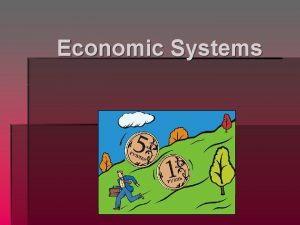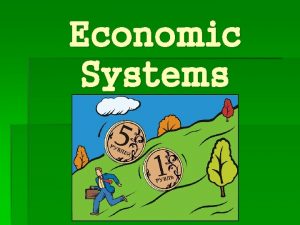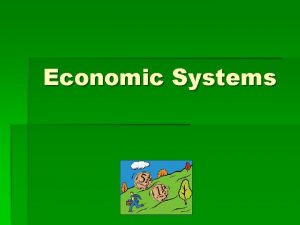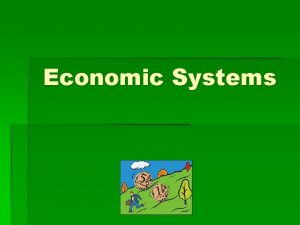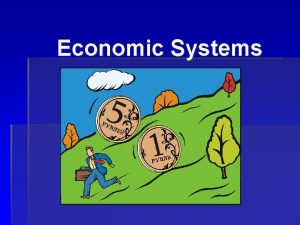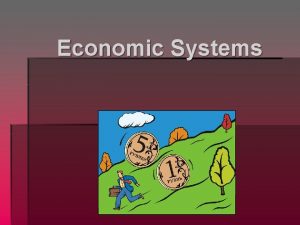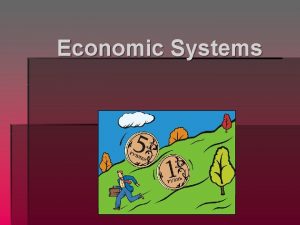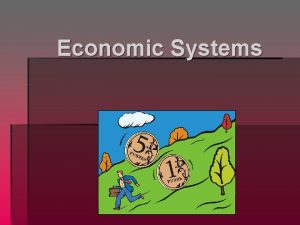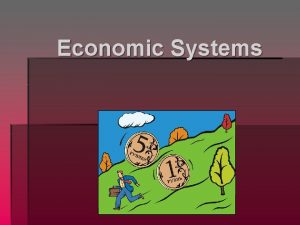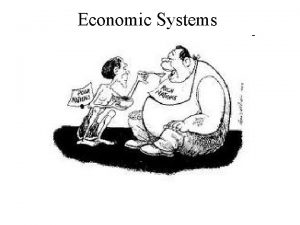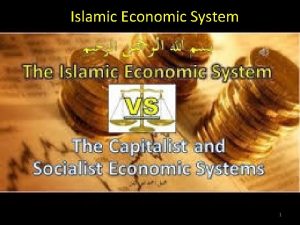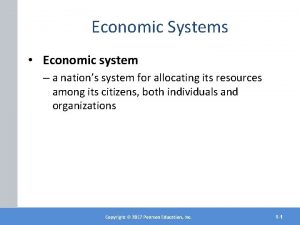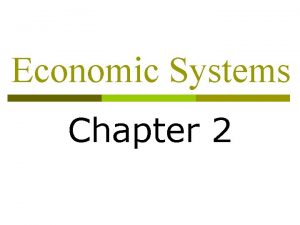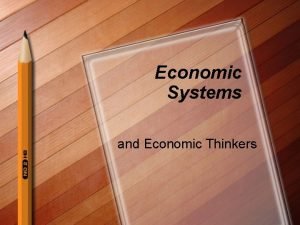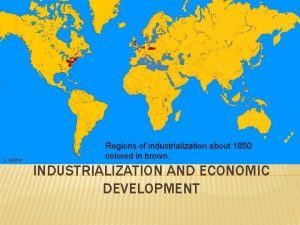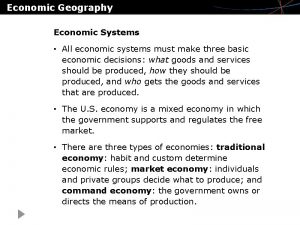The Economic System Chapter 17 The Economic System










































- Slides: 42

The Economic System Chapter 17 The Economic System at Work p 447 -460 Business Organization p 460 -465 Making Business Decisions p 466 -469

P 450 -452 Economic Systems PART 1: THE ECONOMIC SYSTEM AT WORK

Economic Systems • How people get the things they want is determined by a country’s economic system • The nature of economic systems varies widely from place to place • Economic systems help people create and obtain the goods and services they need

Needs vs. Wants NEEDS WANTS • Requirements to survive • All people have same needs: • Things to make life easier & more enjoyable • Cars, computer, cell phone • Food and water • Shelter • Clothing • Different people have different wants • They never change • May change over time • They are subjective • They are objective People satisfy their WANTS by obtaining goods and services How people obtain goods and services is determined by their economic system

Free Market • People are free to own property, to create companies and to buy products as they choose • Free Market is the right to buy & sell goods as you want • Companies must be free to compete with each other • Competition among sellers is the main factor in setting prices • Sellers try to set their prices lower than their competitors so people will buy them • But can’t set prices so low that they don’t make a profit

Wants satisfaction chain the process of obtaining goods and services to satisfy your wants Human wants Want satisfaction achieved Makes goods available for consumption Use resources to produce Results in goods and services

3 Types of Economic Systems Traditional • Economic decisions based on past activity • Subsistent -Grow own food and make own goods • Barter for needed goods • May or may not use money for trade Command Market • Government makes all economic decisions • Government controls all capital, tools and production equipment • Complete Government control of production • What can produce • How much to charge for it • Communist countries used command system • N. Korea & Cuba • Economic decisions made by Individuals in personal and family best interest • Anyone can start a business as long as product is legal • Set prices based on what market will bear • Opposite of a command economy • Based on Freedom of choice • United States and most other countries use

Review • Need vs. Want • Want-Satisfaction chain • • • Want established Find resources to create product Results in a product Product available to consume product purchased and want satisfied • 3 basic Economic Systems • Traditional • Command • Market • Free Market

P 453 -458 Life in a Market Community The US Economic System PART 2: THE ECONOMIC SYSTEM AT WORK

Competition for resources • Profit is the money that a business has left after it has paid its expenses • Profit motive – desire to make a profit • In order to make profit have to provide goods or services • Need resources to make a product • Resources are limited • Must compete for resources • Competition eventually affects price of goods Profit Provide goods or services Limited Resources Compete for resources price of goods

• • Scarcity- the lack of a particular resource When a resource is scarce, it is harder for producers get Products made with that resource are also harder to get The result, prices for these products rise

Law of Supply & Demand Law of Supply Law of Demand • BUSINESSES will produce more products when they can sell them at higher prices • BUISNESSES will produce fewer products when prices are low • Businesses are more eager to provide a product for a high price than a low price • Ex: Mowing lawns • BUYERS will demand a greater quantity of goods when its price is low • As price rises BUYERS will buy less of the product and demand will fall • Buyers are more eager to buy a product for a low price than a high price • Ex: Buying CD’s

Goal is for Supply of a product & Demand for a product to balance each other

Balancing Supply & Demand • You are selling lemonade • It costs $1 to make a glass of lemonade • If you sell a glass for $10 • you will make lots of profit • not many people will want to buy it – low demand • You will have lots of lemonade left over – high supply • If you sell a glass for 5 cents • You will lose money • Lots of people will want to buy it – high demand • You won’t have any lemonade – low supply • If you sell a glass for $2 • you will make profit • Average amount of people will buy it - balanced demand • You will have enough supply – balanced supply


Free Enterprise • Free Enterprise – businesses may operate however they see fit, with little direction or influence by government • Offers the opportunity to make HUGE profits • Bill Gates – Microsoft • Steve Jobs – Apple • Possibility of huge profits also mean possibility of huge losses • Main Risk that business men face in Free Enterprise System is that their business might fail • Competition is vital to free enterprise • Competition is main factor in setting prices • Competition drives companies to improve products

Innovation & Free Enterprise • Innovation is important to Free Enterprise • Improve old products • create new products

Protecting Innovations • Patent – exclusive right to sell your invention for a certain # of years • Copyright – exclusive right to publish or sell a piece of writing, music or art

Capitalism • Capitalism is an economic system in which productive resources are owned by private citizens • Capitalism is closely linked to market economy • People are free to buy and sell as they please • Capitalism encourages people to invest their money in companies • If company is successful can make huge profits and those profits are passed on to the investors

What Consumers want Businesses produce

Monopolies • Competition is good for economy, lack of competition weakens economy • Monopoly - where only 1 company is selling a product or providing a service • A company with a monopoly can set any price it wants • Monopolies are illegal in the US • The US government watches businesses to see that no new monopolies are formed

Mixed Economy Government regulations are meant to protect people, they protect workers, the natural environment and control some prices through subsidies

American Business • Today most companies in America are huge • Mc. Donalds • Apple • Nike • • In the early days of America most businesses were small In the late 1800’s large business began to develop in the US Today Big Business is essential to the US economy Conglomerates –a merger of businesses that produce, supply or sell a number of unrelated goods • GE General Electric • Dow Chemical • Time Warner • Today there is a mix of large and small companies

Review • Profit – • is the money a business has left after it has paid its expenses • Scarcity • is the lack of a particular resource • Law of Supply – • businesses will produce more products when they can sell them at a higher rate • Law of Demand – • buyer will demand a greater quantity of a good when the price is low • Free Enterprise – • business owners will operate however they see fit • Capitalism – • encourages people to invest their money • Monopoly – • a company that so dominates the market that it is effectively the a product or service • Government regulation is used • to protect citizens and the natural environment

American businesses may be organized as sole proprietorships, partnerships, corporations, or nonprofit organizations P 460 -465 Economic Systems PART 2: BUSINESS ORGANIZATIONS

Types of business Organization • How your business is organized depends on its size and complexity • American businesses may be organized as • • Sole proprietorships Partnerships Corporations Nonprofit organizations

Sole Proprietorship • A small businesses owned by one person • Owners keep all profits • Owner supply capital, hire help, and pay taxes; • Owner solely responsible for losses • Not permanent, Proprietorship ends at death of owner • Most US businesses are sole proprietorships Partnership • Two or more people share responsibilities, costs, profits, and losses • Partnerships have same responsibilities and risks as Sole proprietorship • Often more successful than sole proprietorships • Problems arise if partners don’t agree on running of business • Not permanent, partnership ends at death of a partner

Corporation • Permanent organizations, most common form for large companies • Raise money by selling stocks • Shareholders receive a portion of the profits in relation to their holdings. - dividends • States issue charters of incorporation, and corporation obeys regulations. • Stockholders elect directors and vote on changes. • Board of directors selects corporate officers to oversee daily operations. • No one is responsible for a corporation’s debt if it fails

Basic organizational structure of a Corporation

The 5 Most Important Features of a Corporation raising money meeting debt responsibilities securing the rights to operate electing directors choosing executives

Preferred Stock • Less risky • Dividends guaranteed if company is profitable • Stockholders do not usually vote in company’s affairs Common Stock • more risky • Dividends only when company is very profitable • Benefits include • possibility of higher dividends • increased stock value • voting on company’s affairs

Non-Profit Organization • Businesses that provide good and services without seeking a profit • Do not make a profit so are not taxed by government • Most use donations from individuals to operate

Non- Profit Organizations

Business owners must make decisions about their use of natural resources, capital, labor, and entrepreneurship. Business owners are free to make these decisions with little interference from the government P 466 -469 Economic Systems PART 2: MAKING BUSINESS DECISIONS

Natural Resources Entrepreneurship 4 factors of production Labor Capital

Natural Resources • Are the raw materials needed for business and the physical space the business occupies • Natural resources are limited • Only a factor when it affects the cost of the good produced The physical location of a business is a key to it’s success

Capital • Capital—is the resources you need to start a business Capital Goods physical stuff you need to create a product Financial Capital Money used to buy capital goods

Labor The workers required to produce the good or service of the business Workers can be paid hourly wages or salaried earnings Productivity - the amount of work produced by a worker per hour decisions, risks, and Entrepreneurship initiative, management involved in a business Entrepreneurs put up own capital and take all the risk of failure Great Risk = Great Profit or Great Failure


Protects against monopolies Protects a person’s right to own property discrimination Government influences businesses through REGULATION Minimum wage Protects worker’s health and safety Buy and sell goods and services Taxes businesses Small Business Administration MAJOR DEBATE OVER HOW MUCH FEDERAL REGULATION OF BUSINESS THERE SHOULD BE.

EXTRA SLIDES

A Mixed Economy • There is some government regulation of the economy • Government regulations are meant to protect people • Regulations to protect workers • Minimum wage • Worker safety • discrimination • Regulations to protect natural environment • Limits on chemicals released into air & water • Regulations to control prices • Government subsidies - $ paid to farmers to limit or increase production of a crop
 Economic growth vs economic development
Economic growth vs economic development Economic growth and development
Economic growth and development Economics unit 1 lesson 2 difficult choices
Economics unit 1 lesson 2 difficult choices Hát kết hợp bộ gõ cơ thể
Hát kết hợp bộ gõ cơ thể Bổ thể
Bổ thể Tỉ lệ cơ thể trẻ em
Tỉ lệ cơ thể trẻ em Gấu đi như thế nào
Gấu đi như thế nào Tư thế worm breton
Tư thế worm breton Chúa yêu trần thế alleluia
Chúa yêu trần thế alleluia Môn thể thao bắt đầu bằng chữ f
Môn thể thao bắt đầu bằng chữ f Thế nào là hệ số cao nhất
Thế nào là hệ số cao nhất Các châu lục và đại dương trên thế giới
Các châu lục và đại dương trên thế giới Công thức tính thế năng
Công thức tính thế năng Trời xanh đây là của chúng ta thể thơ
Trời xanh đây là của chúng ta thể thơ Cách giải mật thư tọa độ
Cách giải mật thư tọa độ Làm thế nào để 102-1=99
Làm thế nào để 102-1=99 độ dài liên kết
độ dài liên kết Các châu lục và đại dương trên thế giới
Các châu lục và đại dương trên thế giới Thơ thất ngôn tứ tuyệt đường luật
Thơ thất ngôn tứ tuyệt đường luật Quá trình desamine hóa có thể tạo ra
Quá trình desamine hóa có thể tạo ra Một số thể thơ truyền thống
Một số thể thơ truyền thống Cái miệng nó xinh thế chỉ nói điều hay thôi
Cái miệng nó xinh thế chỉ nói điều hay thôi Vẽ hình chiếu vuông góc của vật thể sau
Vẽ hình chiếu vuông góc của vật thể sau Nguyên nhân của sự mỏi cơ sinh 8
Nguyên nhân của sự mỏi cơ sinh 8 đặc điểm cơ thể của người tối cổ
đặc điểm cơ thể của người tối cổ Ví dụ về giọng cùng tên
Ví dụ về giọng cùng tên Vẽ hình chiếu đứng bằng cạnh của vật thể
Vẽ hình chiếu đứng bằng cạnh của vật thể Phối cảnh
Phối cảnh Thẻ vin
Thẻ vin đại từ thay thế
đại từ thay thế điện thế nghỉ
điện thế nghỉ Tư thế ngồi viết
Tư thế ngồi viết Diễn thế sinh thái là
Diễn thế sinh thái là Dot
Dot Bảng số nguyên tố
Bảng số nguyên tố Tư thế ngồi viết
Tư thế ngồi viết Lời thề hippocrates
Lời thề hippocrates Thiếu nhi thế giới liên hoan
Thiếu nhi thế giới liên hoan ưu thế lai là gì
ưu thế lai là gì Khi nào hổ con có thể sống độc lập
Khi nào hổ con có thể sống độc lập Khi nào hổ con có thể sống độc lập
Khi nào hổ con có thể sống độc lập Hệ hô hấp
Hệ hô hấp












































